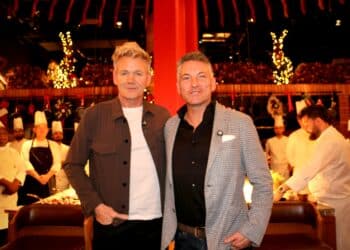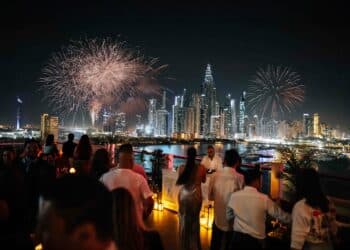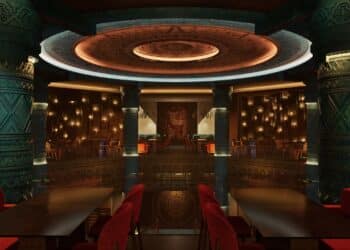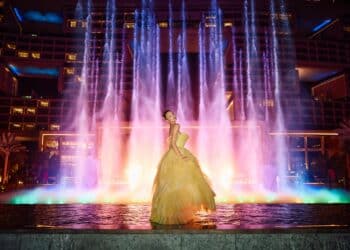Lighting is no longer just a necessity, it has become a statement for many hotels as lobbies and dining areas turn into a wild creation of eclectic luminaire fixtures. Hotel News ME hears from leading lighting suppliers in the Middle East to uncover the latest motion sensor technologies and why LED lighting is presenting sustainable opportunities for hotels.

What are some of the latest trends in the market for lighting features and products?
Scholte: The millennials of today are the first truly digital generation and their desire for personalised experiences is shaping a new reality for hotel owners and operators. Lighting has become an integral part of the ‘internet of things’ and our aim at Philips Lighting is to ensure hotel guests’ physical and emotional comfort by offering systems and services that deliver value beyond illumination.

Jean: Following the transition to LED technology we are now witnessing the next industrial revolution called the Internet of Things (IoT). As technology progresses, we will not only connect luminaires with each other, but deliver value that goes far beyond just lighting structures. Personalisation is also a key topic at the moment, whether it be in a work environment, shopping experiences or a visit to a restaurant. It is all about individuals taking control of their own lit environment. Our intelligent control systems that connect to smart phones allow colour changing or dimming of individual luminaires at the push of a button.
Padula: LED lighting is presenting sustainable opportunities for both design and energy savings. The Tunable White, which tunes the colour temperature from 2700K to 5700K is something else that we are seeing in today’s market. Being able to choose the correct colour temperature for lighting is essential and this feature allows designers to satisfy the widest range of application requirements.
Suneja: Technology has overtaken orthodox techniques across the lighting industry and some of the latest trends include: Built-in LED light sources, as LED sources are known for their long-life properties. Wireless light controls – which uses the main power lines to carry data to and from fittings. Indoor positioning – this tracks people’s position using LED luminaires through their smartphones and are based on visible light communication. Lastly, Li-Fi – Light over Wi-Fi, a super-fast data transmission that works by pulsing the LED light at extremely high frequencies which is undetectable to the human eye.
Griger: Definitely kinetic and dynamically-lit lighting installations, which can create a very unique experience. One of the latest examples of such an installation is the Dubai Opera House, which recently opened and LASVIT worked on the main feature.

What materials are currently popular and why?
Padula: There isn’t too many new materials, but how we are using existing materials is in fact changing. For example, a new way to discover dark spaces is by using graphic light to give shapes and character to shadows. A Few millimeters of light create simple, yet highly dynamic shapes, and the luminous lines become at one with the architecture. They subtly highlight architectural features and create magical atmospheres by giving surfaces a sense of infinity. This is an innovative way to highlight paths, design textures and even adding colour to environments. The light communicates and almost speaks by means of graphic strokes, graffiti and interruptions. It highlights corners and edges, decorates surfaces and emphasises volumes.
Griger: Hand-blown bohemian crystal glass. It is a very delicate and precious material, which was conceived some 800 years ago. It has great optical qualities and is used for most of our installations.
Jean: The classic white trim around a downlight is still very popular. However, we are also seeing a lot of matte beige and glossy dark colours coming in which is generally aimed at the new age traveller.
Suneja: LED lamps are more popular than ever. These lamps are an energy efficient source of light for short distances and small areas. The typical LED only requires 30-60 MW to operate and it is durable and shockproof unlike glass bulb lamp types.

Scholte: It’s about giving guests something they’ll look back on with pleasure. So they’ll want to come back. Lighting sets the scene for these experiences and memories. Flexible and dynamic, it can create appealing ambiences that meet the diverse aspirations of today’s hospitality guests. Large windows or skylights in a hotel will not only make guests and staff feel good, but daylight sensors can dim luminaires gradually down for perfect constant light, harvesting daylight and saving energy. We see many lighting products now being integrated with a control system. Lighting controls combined with modern high-quality LED technology provides the possibility to bring dynamics, atmosphere and accents to the hotel, making the overall experience more interesting and saving on energy and maintenance costs at the same time.
How has technology changed the way lighting fixtures are designed and constructed?
Padula: Advancements in technology has helped to create flexible shapes in lighting strictures, some that almost disappear through their integration and into the surrounding architecture.
Jean: LED lights have made it possible to reduce the size of light fixtures and the quantity of material used to construct them. We are moving away from bulky fixtures with lots of wiring to a minimalistic design where wires and sensors are hidden away and you have a very clean ceiling design. Lighting should blend in with the architecture, provide visibility but also set accents without distracting from the actual object or space. Due to the ever changing technology it is also important to adapt the future-proof concept while designing and manufacturing lights. It should be easy to replace current technology with future technology without changing the entire light fitting.
Griger: We are using the latest programmes, which allow our designers and engineers to prepare very realistic design proposals and visuals for our clients. What is very important is the knowledge and expertise our teams have. We combine traditional materials with progressive contemporary designs aided by the latest technological innovations for our industry.
Scholte: The application of traditional lighting products such as halogen lamps and fluorescent tubes is changing rapidly towards LED technology. LEDs are a smaller light source and can be built into slimmer fixtures, these can be integrated in the architecture in a better way than before. At the same time, heat management is an important element in the construction of LED products as high product temperatures have a big impact on a bulbs lifespan. For example, façade lighting in the Middle East, high ambient temperatures have to be taken into account when designing a product.
What are the product specifications hotels in the Middle East look for when purchasing lights and lighting solutions?
Griger: Hotels are looking for statement pieces that add both value to their project and attract guests. People love to take pictures and share them on social media and with friends, so having a statement piece encourages this kind of interaction. We often find that pictures are taken in front of our installations, which act as an essential feature for the entry to the lobby or other important public areas in the hotel.

Padula: Hotels are looking for the latest technology and attention to detail. Hotels also require a product that is of high quality, reliable and can guarantee a long life with minimal maintenance. They also require a high level of design and products that is aesthetically appealing without compromising on the quality and efficiency of the luminaire. All this can be obtained through constant innovation and dialogue with the architects and designers working on their project.
Scholte: Apart from good quality light, energy savings and the creation of the right ambience in the hotel, hotel operators are increasingly conscious about keeping the hotel as attractive as it was on opening day. If maintenance is handled reactively, faults may be visible to their customers, and replacements can be both inconvenient and time-consuming. Although LED technology has a longer lifetime than traditional lighting, its maintenance requires more lighting knowledge than before. Lifecycle services, to maintain the LED installation in its correct state over the lifetime of the products, is gaining importance.
Suneja: The main consideration for a hotel is the image of the piece as this communicates the story that the hotel wants to tell its guest. Warm lighting is very important for hotels, they want their guests to feel welcome and relaxed as they would be at home.
Jean: Guests staying at a hotel want to experience unique moments and the right lighting solution combined with innovative controls contributes significantly to that experience. Most of the architectural products should be discrete, efficient and elegant while controls should offer a wide range of settings in order to reshape the space according to the time of the day.
Is there more demand for sustainable, eco-friendly products, if so how is this translated across in some of the features of your products?
Padula: We can now illuminate entire surfaces with less than half the quantity of fittings that were needed before. This makes a huge difference in terms of energy saving and the lifespan of the fittings. A good LED light does not necessarily guarantee a good luminaire as it is the entire system that determines the quality of the product, including: The optic system; LED module; dissipation system and driver or power supply are all key elements in maintaining a reliable, energy efficient LED fixture. iGuzzini guarantees its own products for five years, after 50,000 operating hours. Our products maintain 80% of their initial flow, which guarantees significant energy savings.
Griger: Lasvit products are produced from hand-made glass, some of them using a wood finish or frame, such as Fungo chandelier designed by the Campana Brothers. This design duo looked especially into sustainable materials while creating this piece for us.

Scholte: Many hotel owners and operators are aware of their sustainability responsibility. Most newly built hotels apply only LED technology because of the important energy savings. In addition to this we see that the demand for lighting controls, both for guest rooms and common areas, is increasing as this can bring substantial extra cost savings. For example, presence detection sensors can help to switch off the lights when nobody is around, but it can also trigger the air-conditioning to change temperature. Philips Lighting has a wide range of products available that cover all areas and applications in and around the hotel, and we are also offering control solutions with it, ensuring a perfect integration. Furthermore, Philips Lighting supports the Global Lighting Challenge – a campaign to deploy 10 billion high efficiency, high quality affordable light bulbs (such as LED) to combat climate change. The challenge was launched by the Clean Energy Ministerial at the COP21 UN Climate Change Summit.
Jean: In the past, LED lights have helped us reduce the energy consumption of a luminaire by 70%. This can mean remarkable savings and also help achieve greater LEED certification levels. But it is also essential to speak about the importance of lighting controls. Daylight sensors measure the actual daylight inside the room and adjust the artificial light accordingly, to ensure excellent visibility. This also means that on a sunny day, artificial light may not be required at all between certain times. In the back of house areas and staircases it makes sense to install presence detection, especially in areas that are not used that frequently. Ensuring that light is only on when really needed and also adjusting the light levels to the actual requirement.
Where do ideas for new design concepts come from?
Padula: It is essential to listen to the client and monitor new trends and ideas coming from the creative world. iGuzzini boasts a longstanding collaboration with internationally renowned designers and architects who have hugely contributed to the company’s success in terms of product development and aesthetic research and innovation. Inspiration can come from all over the world, lighting isn’t just confined to the likes of a lamp or chandelier.
Scholte: Philips Lighting closely monitors trends in the market, talking to customers but also to other stakeholders in the industry, such as lighting designers and architects. Based on their input, combined with our extensive R&D efforts, we create new concepts and test them thoroughly before we bring them to the market.
Jean: The Middle East is a melting pot at the crossroads of orient and occident. Some of the newer hotels such as the Four Season, or the Madinat Jumeirah phase IV are still inspired by Arabic tones with wind towers and sandy façades, while other hotels, such as the W have more of an occident influenced design with contemporary art pieces in the lobby. It is interesting to see how these different design styles come together and create new fresh concepts.
Griger: That varies from project to project. It might be the history of the country and its natural environment but there is always a story behind our pieces. As an example, the dynamically-lit glass sculpture, Symphony in the main foyer of the Dubai Opera was inspired by the elements of water and Dubai’s maritime past. Composed of thousands of individually crafted glass pearls, the very concept of pearls adds preciousness, rarity and timelessness, which are all qualities that are inherently present in hand-blown glass and crystal. The overall shape of the sculpture draws further inspiration from fishing nets in a vortex of bubbles, rising through the depths of the sea.
Suneja: Inspiration comes from all over, but for example, verbal concepts tend to lean toward the abstract. They are focused on the message your design is to communicate. Secondly you have visual designs – the visual parts of your concept might be a specific image or colour scheme. Visual concepts tend to be a little more concrete and should come from the verbal part of your concept.
What safety features should hotels take into consideration when choosing lights?
Griger: The safety of Lasvit lighting installations is always a high priority. Our lights are usually very large pieces, some weighing more than a ton and they hang in public spaces. We always pay the utmost attention to safety and every element is secured at least twice. We also provide regular maintenance of our pieces to ensure their safety and superior appearance.
Padula: International certifications and compatibility with control systems need to be included in the development of the lighting scheme before any hotel or establishment decides to install any kind of fixture.
Scholte: Fire safety is a concern in the Middle East after the recent problems in several towers. Selected products should carry the right certification, and preferably also origin from an experienced and reputed manufacturer. Often overlooked is the aspect of easy installation and ergonomic product design. This can contribute to better installation of the lights in the ceiling, further reducing the risk of incidents.
Jean: Lighting plays a crucial role in any building’s safety. It is very important to look out for fire ratings, ambient temperatures and humidity levels depending on the area of the hotel. Emergency lighting can save lives in the case of an unforeseen situation and ensure a smooth escape from the building.
Suneja: All electrical equipment should be properly installed and kept in good condition with the installations protected from any moisture or particles as wet, dirty, dusty or corrosive conditions can breach safety regulations and put guests at risk.


































































